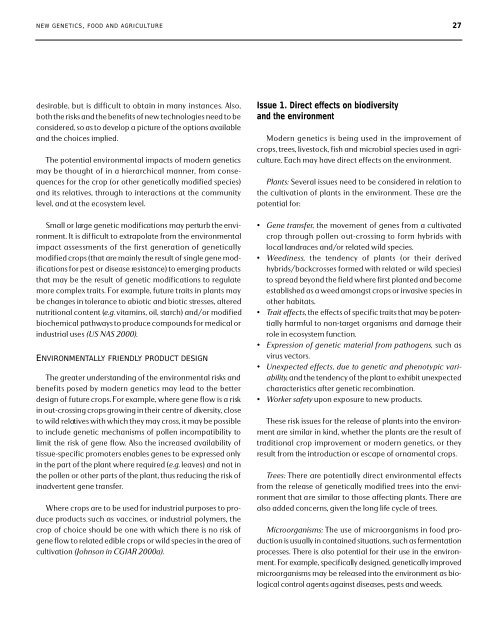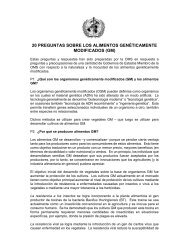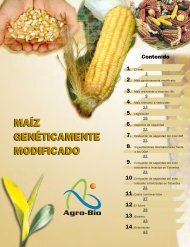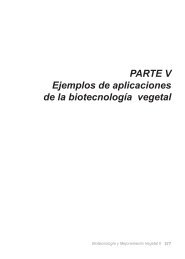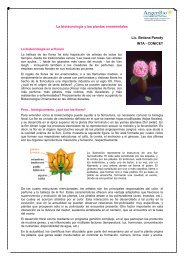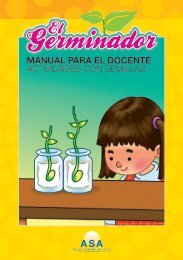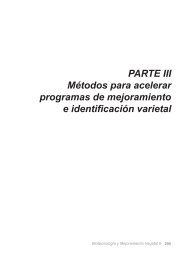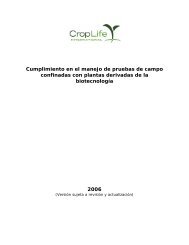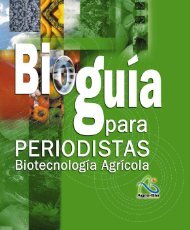26N E W G E N E T I C S, F O O D A N D A G R I C U LT U R E4. Implications for Biodiversity Conservation <strong>and</strong>Environmental SustainabilityIssuesFour issues are important in assessing the effects of moderngenetics on biodiversity <strong>and</strong> the environment. These are:• Direct effects on the environment, that may result from therel ease of geneti ca l l y/l iving mod i fi ed org anisms into th eenvironment;• I n d i rect effects th at may result from chan g es in agr i cu l-tural pra c ti ces, as a result of the appl i cations of mod e r ngenetics in agriculture <strong>and</strong> the environment;• A d e q u a cy of the meth ods us ed to as s ess the impact of moder n genetics on the environment;• Usefulness of molecular methods in the characterization,conservation <strong>and</strong> use of biodiversity.The areas of scientific convergence, divergence <strong>and</strong> gapsin knowledge are summarized in Table 4.1. Their implicationsare discussed below.Key DocumentsThe environmental issues have been examined in detail ins eve ral specialised stu d i es publ i shed by inte r n ational agenci es (e .g. Euro pean Commission, EC 2001a; Euro pean EnvironmentAgency, Eas th am <strong>and</strong> Sw ee t, 2002; OECD 2001b ;)<strong>and</strong> national agencies (e .g. US NRC 2000; US NAS 2002;CAST 2002; US NCFAP 2002). Environmental issues also forman impo r tant co m ponent of seve ral broader stu d i es byn ational agencies (e .g. Bel g i um, VIB 2001; Canada Roy a lSoc i e ty 2001; CBAC 2001, 2002; Fran ce, Academie des Sc i-ences 2002; <strong>New</strong> Zeal<strong>and</strong> 2001).The env i ro n m e n tal risks as s oc i ated with the re l e ase ofg e n e ti cally mod i fied crops in the env i ronment have alsobeen rev i ewed by Cook, <strong>and</strong> by Johnson, in CGIAR 2000a;Dale et al. 2002; Nap et al. 2003; <strong>and</strong> Conner et al. 2003. Therisks <strong>and</strong> benefits of specific cases have been reviewed for Btcotton (ISAAA 2002 <strong>and</strong> Pray et al. 2002) <strong>and</strong> other Bt crops(Shelton et al. 2002). The possible effects of genetically engineeredcorn on the Monarch butterfly are discussed in severalp u bl i cations by the US National Aca d e my of Sc i e n ces(e.g. Zangerl et al. 2001), <strong>and</strong> also by Shelton <strong>and</strong> Sears 2001;<strong>and</strong> the Pew Initi ative 2002). The spe c i fic issues as s oc i ate dwith the possible release of transgenic fish into the environmenthave been reviewed by the Pew Initiative (Pew 2003).OverviewA gr i cu l ture affects the envi ro n m e n t . <strong>New</strong> genetic te c h-nologies that a re used in agriculture will affect the environment.Their environmental effects may be either positive orn e g ative. They may either acce l e rate the env i ro n m e n ta l l yd amaging effects of agr i cu l ture, or th ey may co n tr i b utetowards more sustainable agricultural practices <strong>and</strong> the conse rvation of natural res o urces. It is a matter of appl i cati o n<strong>and</strong> choice.The env i ro n m e n tal effects will depend on the spe c i fi cgenetic application, the agricultural system <strong>and</strong> the environment(agro - e co sys tem) in which it is used. Env i ro n m e n ta limpact needs to be assessed on a case-by-case basis, takingaccount of specific risk factors. The environmental effects ofspecific technologies may be either direct effects of a specifictrai t /s pe c i es co m b i n ation on biod ive rs i ty, habitat s, lan d-scape, <strong>and</strong>/or other components of the environment; or theymay be indirect effects, resulting from changing agriculturalpractices leading to more, less or different use of pesticides orherbicides, <strong>and</strong>/or changing l<strong>and</strong> uses.In assessing direct <strong>and</strong> indirect environmental effects, newb i o te c h n ol ogy - based te c h n ol og i es need to be co m pare dw i th present agr i cu l tural pra c ti ces, <strong>and</strong> other te c h n ol ogyo p tions. Co m parison with baseline ecol og i cal data is also
N E W G E N E T I C S, F O O D A N D A G R I C U LT U R E 27d es i ra ble, but is diffi cult to ob tain in many instan ces. Al s o,both the risks <strong>and</strong> the benefits of new technologies need to beconsidered, so as to develop a picture of the options available<strong>and</strong> the choices implied.The potential environmental impacts of modern geneticsm ay be thought of in a hierarc h i cal man n e r, from co n s e-quences for the crop (or other genetically modified species)<strong>and</strong> its re l atives, th rough to inte ra c tions at the co m m un i tylevel, <strong>and</strong> at the ecosystem level.Small or large genetic modifications may perturb the environment.It is difficult to extrapolate from the environmentali m pact as s essments of the fi rst generation of geneti ca l l ymodified crops (that are mainly the result of single gene modificationsfor pest or disease resistance) to emerging productsth at may be the result of genetic mod i fi cations to re g u l atemore complex traits. For example, future traits in plants maybe changes in tolerance to abiotic <strong>and</strong> biotic stresses, alterednutritional content (e.g. vitamins, oil, starch) <strong>and</strong>/or modifiedbiochemical pathways to produce compounds for medical orindustrial uses (US NAS 2000).ENVIRONMENTALLY FRIENDLY PRODUCT DESIGNThe greater underst<strong>and</strong>ing of the environmental risks <strong>and</strong>be n e fits posed by modern geneti cs may lead to the be tte rdesign of future crops. For example, where gene flow is a riskin out-crossing crops growing in their centre of diversity, closeto wild relatives with which they may cross, it may be possibleto include genetic mechanisms of pollen inco m pati b i l i ty tolimit the risk of gene fl ow. Also the incre ased avai l a b i l i ty oftissue-specific promoters enables genes to be expressed onlyin the part of the plant where required (e.g. leaves) <strong>and</strong> not inthe pollen or other parts of the plant, thus reducing the risk ofinadvertent gene transfer.Where crops are to be used for industrial purposes to produce products such as va cc i n es, or indus trial pol y m e rs, th ec rop of choice should be one with which th e re is no risk ofgene flow to related edible crops or wild species in the area ofcultivation (Johnson in CGIAR 2000a).Issue 1. Direct effects on biodiversity<strong>and</strong> the environmentModern geneti cs is being used in the improvement ofcrops, trees, livestock, fish <strong>and</strong> microbial species used in agriculture.Each may have direct effects on the environment.Plants: Several issues need to be considered in relation tothe cu l tivation of pl ants in the env i ronment. These are th epotential for:• Gene tran s fe r, the movement of genes from a cu l tivate dc rop th rough pollen out - c rossing to form hybrids withlocal l<strong>and</strong>races <strong>and</strong>/or related wild species.• Weed i n es s, the te n d e n cy of pl ants (or their derive dhybrids/backcrosses formed with related or wild species)to spread beyond the field where first planted <strong>and</strong> becomeestablished as a weed amongst crops or invasive species inother habitats.• Trait effects, the effects of specific traits that may be potentiallyharmful to non-target organisms <strong>and</strong> damage theirrole in ecosystem function.• Ex p ression of genetic material from path og e n s, such asvirus vectors.• Un e x pec ted effec t s, due to genetic <strong>and</strong> ph e n o typic var i-ability, <strong>and</strong> the tendency of the plant to exhibit unexpectedcharacteristics after genetic recombination.• Worker safety upon exposure to new products.These risk issues for the release of plants into the environmentare similar in kind, whether the plants are the result oftra d i tional crop improvement or modern geneti cs, or th eyresult from the introduction or escape of ornamental crops.Trees: T h e re are po te n tially direct env i ro n m e n tal effe c t sfrom the release of genetically modified trees into the environmentthat are similar to those affecting plants. There arealso added concerns, given the long life cycle of trees.M i c roo rg an i s m s : The use of microo rg anisms in food produc tion is usually in co n tained situ ati o n s, such as fe r m e n tati o np roces s es. There is also po te n tial for their use in the env i ro n-ment. For exam ple, spe c i fi cally des i gn e d, geneti cally improve dm i c roo rg anisms may be re l e ased into the env i ronment as biolog i cal co n trol agents against diseas es, pests <strong>and</strong> weeds.
- Page 1 and 2: I N T E R N ATIONAL COUNCIL FOR SCI
- Page 3 and 4: I N T E R N ATIONAL COUNCIL FOR SCI
- Page 7 and 8: N E W G E N E T I C S, F O O D A N
- Page 10 and 11: 8N E W G E N E T I C S, F O O D A N
- Page 12 and 13: 10N E W G E N E T I C S, F O O D A
- Page 14 and 15: 12N E W G E N E T I C S, F O O D A
- Page 16 and 17: 14N E W G E N E T I C S, F O O D A
- Page 18 and 19: 16N E W G E N E T I C S, F O O D A
- Page 20 and 21: 18N E W G E N E T I C S, F O O D A
- Page 22 and 23: 20N E W G E N E T I C S, F O O D A
- Page 24 and 25: 22N E W G E N E T I C S, F O O D A
- Page 26 and 27: 24N E W G E N E T I C S, F O O D A
- Page 30 and 31: 28N E W G E N E T I C S, F O O D A
- Page 32 and 33: 30N E W G E N E T I C S, F O O D A
- Page 34 and 35: 32N E W G E N E T I C S, F O O D A
- Page 36 and 37: 34N E W G E N E T I C S, F O O D A
- Page 38 and 39: 36N E W G E N E T I C S, F O O D A
- Page 40 and 41: 38N E W G E N E T I C S, F O O D A
- Page 42 and 43: 40N E W G E N E T I C S, F O O D A
- Page 44 and 45: 42N E W G E N E T I C S, F O O D A
- Page 46 and 47: 44N E W G E N E T I C S, F O O D A
- Page 48 and 49: A n n e x e sA. Bibliographic ListB
- Page 50 and 51: N E W G E N E T I C S, F O O D A N
- Page 52 and 53: N E W G E N E T I C S, F O O D A N
- Page 54 and 55: N E W G E N E T I C S, F O O D A N
- Page 56 and 57: N E W G E N E T I C S, F O O D A N
- Page 58: I N T E R N ATIONAL COUNCIL FOR SCI


